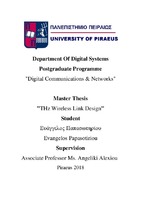THz wireless link design

Προβολή/
Λέξεις κλειδιά
THz ; Wireless ; Transmission windows ; Sub bands ; Capacity ; Spectral efficiency ; SER ; SNR ; Absorption coefficient ; Molecular absorption loss ; Colored noiseΠερίληψη
The proliferation of wireless devices in recent years in combination with the need of high throughputs per user and zero latency (less than 1 ms) pushes current technologies and available spectrum to the limit. Even though wireless world is moving to the 5G (fifth generation) era, which contains many promising technological advances e.g massive MIMO (Multiple Input Multiple Output) systems, full duplexing e.t.c, still there is a lack of efficiency and flexibility in handling huge amount of QoS/QoE (Quality of Service / Experience) oriented data. To overcome these problems and provide unprecented capacity using ultra wide bandwidths THz band (0.1-10 THz) looks very promising. But high frequencies of THz band create a novel source of noise (colored), which in combination with severe losses give it new peculiar propagation characteristics. Furthermore transmissions depend on the environmental conditions since water vapor concentration and atmospheric temperature effect the propagation. Current work focuses on the initial research of the achievable information theoretical results in the spectrum ranges of 275-400 GHz and 0.1-1 THz. Metrics of capacity, spectral efficiency and symbol error rate for various link distances are employed using frequency bands of the 0.1-1 THz. They are located around the local minima of molecular loss, using a threshold of 3dB defining transmission windows for a certain distance. Next they are divided in equally sized sub bands, where the assumptions of locally flat noise is made to employ the aforementioned metrics. Results suggest that losses imposed by the channel to the transmitted signal are severe, reducing significantly received SNR (Signal to Noise Ratio). Capacity is calculated within the spectrum of 275-400 GHz assuming antenna gains and different environmental conditions showing that beamforming yields better results improving received SNR independently of the changes in weather conditions. Conclusion of this work is that techniques of MIMO, pencil beamforming and high gain transceivers must be used in order to achieve unprecented bandwidth and throughput possibilities given by THz.


